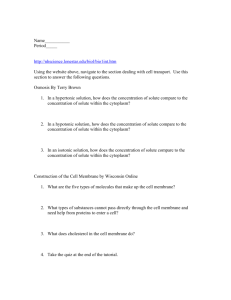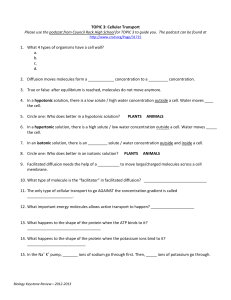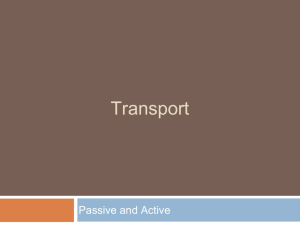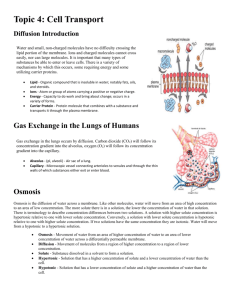CELL TRANSPORT
advertisement
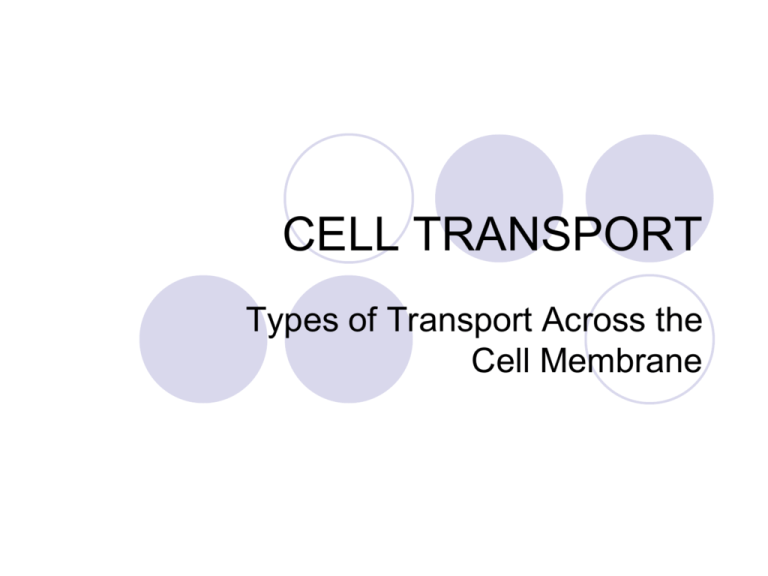
CELL TRANSPORT Types of Transport Across the Cell Membrane Passive Transport: Simple Diffusion Requires NO energy Molecules move from area of HIGH to LOW concentration Passive Transport: Diffusion Diffusion is a PASSIVE process which means no energy is used to make the molecules move, they have a natural KINETIC ENERGY Diffusion of Lipids Diffusion Through a Membrane Solute moves DOWN the concentration gradient. (HIGH to LOW) Passive Transport: Osmosis Diffusion of water across a membrane Moves from HIGH water concentration to LOW water concentration Water is attracted to solutes (like salt) so it will also travel to areas of low solute concentration to high solute concentration. Diffusion of Water Across A Membrane High water concentration Low solute concentration Low water concentration High solute concentration Cells in Solutions Isotonic A solution whose solute concentration is the same as the solute concentration inside the cell. Hypotonic A solution whose solute concentration is lower than the solute concentration inside a cell Hypertonic A solution whose solute concentration is higher than the solute concentration inside a cell. Cell in Isotonic Solution What is the direction of water movement? The solute and water concentrations are the same inside and outside the cell. The cell is at EQUILIBRIUM Water will flow in both directions outside and inside the cell. Cell in Hypotonic Solution What is the direction of water movement? The water is going INSIDE the cell. Water is attracted to the solute inside the cell. The solute concentration is greater inside the cell than outside, therefore water will flow into the cell. Cell in Hypertonic Solution What is the direction of water movement? The water is GOING OUT of the cell. The solute concentration is greater outside the cell, therefore water will flow outside the cell. Cells in Solutions Cells in Solutions Isotonic solution No net movement of water. EQUAL amounts leaving and entering hypotonic solution CYTOLYSIS hypertonic solution PLASMOLYSIS Cells in Solutions Cytolysis Cytolysis in elodea. The destruction of a cell. Cells swell and burst Plasmolysis Plasmolysis in elodea. The shrinking of a cell. Cells shrink and shrivel Normal elodea plant cell Cytolysis & Plasmolysis Cytolysis Plasmolysis Osmosis in Red Blood Cells Isotonic Hypotonic Hypertonic Osmosis in Plant and Animal Cells Passive Transport: Facilitated Diffusion Facilitated Diffusion Does not require energy Uses transport proteins to move high to low concentration Examples: Glucose or amino acids moving from blood into a cell. Proteins are Crucial to Membrane Function Facilitated Diffusion Molecules will randomly move through the pores in Channel Proteins. Types of Transport Proteins Channel proteins are embedded in the cell membrane & have a pore for materials to cross Carrier proteins can change shape to move material from one side of the membrane to the other Facilitated Diffusion Some carrier proteins do not extend through the membrane. They bond and drag molecules through the lipid bilayer and release them on the opposite side. Active Transport Active Transport Requires energy or ATP Moves materials from LOW to HIGH concentration • AGAINST concentration gradient Going against the concentration gradient Active Transport Examples: Pumping Na+ (sodium ions) out and K+ (potassium ions) in—against concentration gradients. Called the SodiumPotassium Pump. Sodium-Potassium Pump 3 Na+ pumped in for every 2 K+ pumped out; creates a membrane potential. Active Transport--Exocytosis Exocytosis Type of active transport Moving things OUT Molecules are moved out of the cell by vesicles that fuse the with the plasma membrane. This is how many hormones are secreted and how nerve cells communicate with each other. Exocytosis Exocytic vesicle immediately after fusion with plasma membrane. Active Transport--Endocytosis Large molecules move materials into the cell by one of three forms of endocytosis. Pinocytosis Receptor-mediated endocytosis Phagocytosis Active Transport-Pinocytosis Most common form of endocytosis. Takes in dissolved molecules as a vesicle. Active Transport-Pinocytosis Most common form of endocytosis. Takes in dissolved molecules as a vesicle. Cell forms an invagination Materials dissolve in water to be brought into cell Called “Cell Drinking” Example of Pinocytosis Transport across a capillary cell (blue). Receptor-Mediated Endocytosis Some integral proteins have receptors on their surface to recognize & take in hormones, cholesterol, etc. Active Transport--Receptor-Mediated Endocytosis Active Transport--Phagocytosis Used to engulf large particles such as food, bacteria, etc. into vesicles Called “Cell Eating” Phagocytosis About to Occur Phagocytosis Phagocytosis - Capture of a parasite (green) by Membrane Extensions of an Immune System Cell (orange) Amoeba eating a bacteria parasite macrophage Crash Course in Cell Transport Crash Course in Cell Transport


